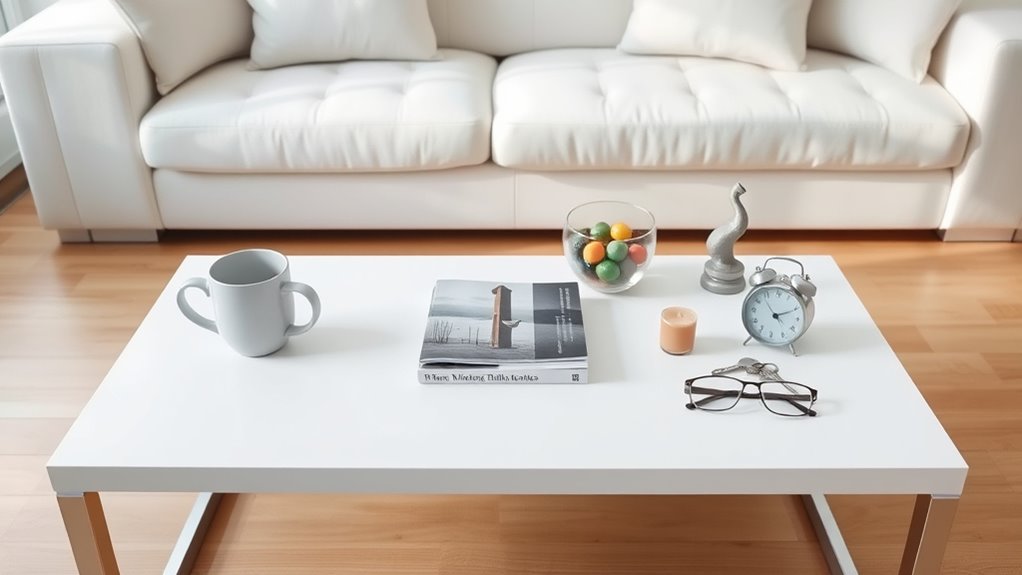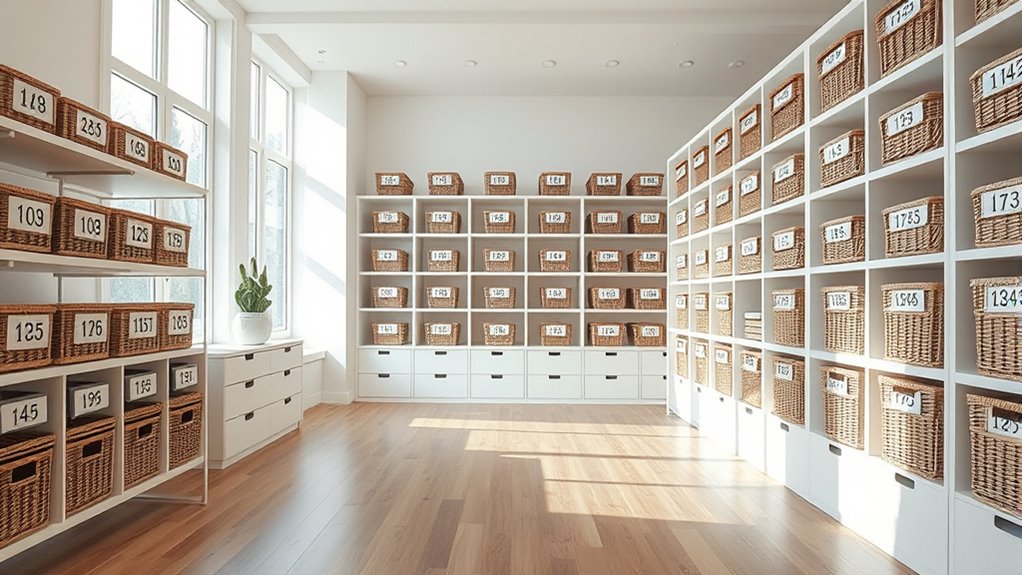The Declutter by Numbers with the 333 Item Home Experiment helps you simplify your space by limiting yourself to just 333 belongings. Break your clutter into small categories like clothes, books, or kitchen items, and decide quickly what to keep, donate, or discard. Focus on making intentional choices to create a calm, functional home. Keep track of your progress for motivation, and learn more about how this method can transform your space step by step.
Key Takeaways
- The 333 Item Home Experiment involves choosing only 33 items per category to reduce overall possessions.
- It promotes intentional decluttering by focusing on quality and purpose over quantity.
- Setting item limits helps simplify decision-making and maintains a minimalist, functional space.
- The method encourages gradual progress through manageable categories, preventing overwhelm.
- This approach fosters long-term organization by establishing clear, designated spots for remaining belongings.

If clutter has taken over your space, breaking the mess into manageable parts can make the task less overwhelming. Tackling a full room or house at once often leads to burnout, so start small. Use simple organizing methods that focus on quality over quantity, helping you stay motivated. A minimalist approach can be your best ally here—by reducing the number of possessions you’re sorting through, you make the process more straightforward and less stressful. Instead of trying to clear everything at once, designate specific areas or categories, such as books, clothes, or kitchen gadgets. This way, you concentrate your efforts, making each step achievable and less intimidating.
When you adopt organizing methods rooted in a minimalist approach, you’re not just tidying up—you’re rethinking how you relate to your possessions. Ask yourself if each item adds value or joy to your life. If it doesn’t, consider letting it go. This mindset helps you declutter intentionally, rather than just moving things from one place to another. To keep things efficient, set a timer for each session, perhaps 15 or 20 minutes. This prevents fatigue and keeps your focus sharp. As you work through each category, make quick decisions: keep, donate, recycle, or discard. Avoid overthinking—trust your instincts to determine what truly belongs in your space.
Breaking clutter into smaller chunks also allows you to see progress more clearly, which fuels your motivation to keep going. It’s easier to stay committed when you notice tangible results, like an empty drawer or a clean shelf. Additionally, understanding the importance of contrast ratio in your space can help you better assess how to set up lighting and screens for maximum clarity and comfort. As you clear each part, think about how you want your space to look and feel. Creating a designated spot for everything and sticking to a minimalist approach ensures your space stays organized longer. This isn’t about perfection; it’s about making your environment functional and calming.
Frequently Asked Questions
How Does the Experiment Impact Long-Term Clutter Habits?
This experiment helps you understand how emotional attachment influences clutter habits, showing that letting go of items can be challenging. By intentionally decluttering, you start to form new habits, making it easier to resist accumulating unnecessary things. Over time, this habit formation reduces long-term clutter, empowering you to maintain a tidier space. It’s about gradually breaking emotional ties to possessions and creating sustainable decluttering routines.
What Tools or Apps Assist With Tracking Item Quantities?
Did you know that over 60% of people find inventory management apps helpful for decluttering? Tracking apps like Sortly or Closet+ make it easy to monitor item quantities, preventing excess. You can organize your belongings, set limits, and see what you own at a glance. These tools help you stay accountable, reduce clutter, and maintain a tidy space effortlessly. With the right app, managing your items becomes simple and stress-free.
Can This Method Be Adapted for Digital Clutter?
You can definitely adapt this method for digital organization by tracking your virtual clutter, like files, emails, and apps. Use tools like file management apps or digital inventories to count and categorize items. Regularly review and delete unnecessary files to keep your digital space tidy. This approach helps you stay organized, avoid overwhelm, and easily find what you need, making digital clutter more manageable and less stressful.
What Are Common Challenges Faced During the Decluttering Process?
When you declutter, you often face challenges like emotional triggers, which make it hard to let go of items. Finding effective storage solutions can also be tricky, especially when space is limited. You might struggle with deciding what to keep and what to discard, but setting clear goals and categorizing belongings helps. Remember, patience and a systematic approach make the process smoother and more manageable.
How Do Emotional Attachments Influence the Decluttering Numbers?
Ever wondered how sentimental value and attachment psychology shape your decluttering numbers? Emotional attachments often make it tough to let go of items, because they carry memories or symbolize important moments. This attachment can inflate the perceived value of possessions, slowing your progress. Do you realize that recognizing these feelings helps you prioritize what truly matters? By understanding your emotional ties, you can make more mindful decisions and declutter more effectively.
Conclusion
As you finish the 333-item journey, remember that less isn’t just about possessions—it’s about making room for what truly matters. Clutter may fill your space, but it can also weigh down your spirit. By letting go of excess, you create clarity and freedom. In shedding the unnecessary, you find a richer, more intentional life. Sometimes, the smallest acts of decluttering reveal the biggest treasures—your time, your peace, and your purpose.









